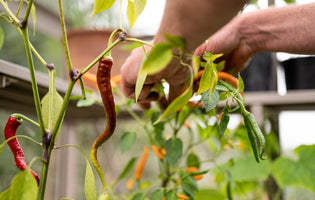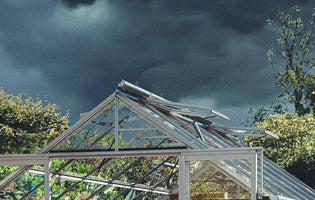When it comes to doing our best to reduce excessive waste, be more environmentally conscious and save our ailing planet, every little helps! You don’t have to rush out and chain yourself to a tree in the Amazon Forest – you can make a significant impact in your own garden just by using your imagination and committing to “reduce, reuse and recycle” as far as possible. Before you toss that tin, bin that bottle or chuck those kitchen scraps – think carefully about how you can upcycle or compost household waste and food scraps.
In this article, we look at how you can:

There are some creative eco-friendly ways to ward off waste, such as mulching old leaves, turning your lunch leftovers into compost, using old CDs to deter thieving birds, creating wildlife buffets from Halloween Jack-o-Lanterns, transforming an old bathtub into an attractive water feature, or even repurposing your Christmas tree.
From greenhouses to get you in the gardening groove to innovative and sustainable ways to collect nutrient-packed rainwater and a host of indispensable accessories, Rhino Greenhouses Direct will get your recycling journey revved up and ready for action!
Clever composting
Making compost is a simple “full-circle” system to use up all your vegetable waste and peels. The waste breaks down into nutrients to feed your garden and bulk to improve the soil, producing more growth and eventually returning to the compost bin! You can also compost your garden cuttings, leaf debris, and woody waste, resulting in a rich, highly versatile organic material supplement for the garden.
Best things to upcycle in your garden
According to this RHS article, “upcycling involves repurposing something so it has a greater value than it had originally. Many common and household items can be 'upcycled' for use in the garden, rather than be discarded at landfill or 'downcycled' into something of lower value”. For inventive ways to use throw-away items, explore www.RecycleThis.co.uk. There’s even a garden category full of ideas to fire you up.
Here are Rhino Greenhouses Direct’s Favorite things to upcycle in your garden:
- Bathtubs, sinks, and buckets: These make amazing ponds when sunk into the ground. You can cultivate a rich ecozystem in your pond by attracting frogs and toads, which will prove very effective at reducing the number of slugs on your plot.
- Windows: These make perfect tops for homemade cold frames to protect your tender plants from late autumn through to spring.
- Pallets: Build a compost bin from these handy structures, which would otherwise go to landfill.
- Wood: Use surplus bits of wood to make compost bins, frames for climbing plants and structures to hold up netting or garden fleece. A very useful source is old scaffolding planks.
- Chicken wire and fencing: Push a few posts into the ground and surround them with old wire fencing, and you have the ideal bin for creating leaf mold.
- Plastic Bottles: Make a marvelous mini-cloche that protects seedlings from slugs, snails and harsh weather.
- CDs and DVDs: Ward off marauding birds by threading these onto individual strings and attaching them to a washing line across areas of your vegetable garden that suffer from crop-stealing culprits.
- yogurt Pots: Can be sunk into the ground and filled with beer or other yeasty liquid to trap and drown slugs.
- Plastic Pipe: Because of the way they naturally keep their shape, they’re perfect for creating tunnel structures or even planters for a wide variety of blooms.
- Old Grapefruit skins and Coconut Shells: Leaving a few on the soil overnight attracts unsuspecting slugs in a “cozy overnight shelter”, after which you can pick up the skins or shells and dispose of the slimy pests.
How to reuse a Christmas tree

Don’t pine for me, oh Christmas tree. The British Christmas Tree Growers Association (BCTGA) sells a whopping 8 to 10 million Christmas trees annually! But what do you do with them once the turkey’s been gobbled and it’s time to take down the tinsel?
There are plenty of wonderful ways to put the wood and needles to good use.
Establish a wildlife shelter
Trim branches to shorter lengths, tie them in a bundle, and then hang them in the garden for bugs to hide in. Or, chop the trunk into pieces and stack the pieces to create a refuge for wildlife.
Mulch ado about nothing
Keep the tree until the needles fall off, then collect them to use as mulch for acid-loving plants such as blueberries. You can also convert it into valuable wood chip mulch by putting it through a shredder. Place the chips at the back of a border for a few months to rot down before using them to mulch around trees and shrubs.
Love me tender
Chop large branches from the tree and lay them over plants on the soil surface as insulation for tender plants to protect them from frost. These 10 common garden plants need winter protection.
Christmas tree climbers
Plant the bare tree in a garden border as a frame for climbing plants such as sweet peas to grow over. You can also use branches as plant supports – store them somewhere dry and use them in the summer. Take inspiration from these 10 scented climbers.
Recycling to the rescue for your Halloween pumpkins

According to this BBC article, the food charity Hubbub estimates that more than half of the 24 million pumpkins carved for Halloween in Britain alone won’t be eaten at all. Thousands of tons of edible pumpkin leftovers get thrown away after the spooky fun of Halloween has passed. The insides of these popular props end up in landfills, creating harmful gases for the environment. But instead of throwing them away, they can be reused to benefit your garden!
Perfect pumpkin planters
Slice off the top and remove the flesh and seeds from the inside. Then fill with potting soil until about one-third full. Place your plant in the pumpkin, then add more soil. You can leave your pumpkin plant on the porch for a few days, and over time the pumpkin will naturally break down, providing fertiliser for your plant.
Compost your pumpkin
Pumpkins break down quickly because they’re 90% water. Remove the seeds to prevent unwanted pumpkin plants from sprouting, then chop them up and place them in the compost bin or pile.
Pumpkin seeds make tantalising wildlife treats
Remove the seeds from your pumpkin, let them dry and lay them on a shallow bird feeder in your garden. You can even mix them with birdseed.
Turn your jack-o-lantern into a bird snack-o-lantern
Cut the pumpkin in half, scoop out the seeds, insert sticks across the open pumpkin to serve as perches, then fill with birdseed and enjoy the feathered feeding frenzy! If you live in the suburbs or a more rural area, you can cut your pumpkin into smaller pieces and leave them for animals such as badgers, deer, rabbits, mice, and squirrels. Just remember that only non-painted are safe for the animals.
Plant pumpkin seeds
Get a head start on Halloween by planting your very own crop for next year!
In conclusion
Three cheers for the three R’s of reduce, recycle, and reuse! By re-purposing the bits and bobs you used to bin, your garden will be brimming with beauty and bounty.







